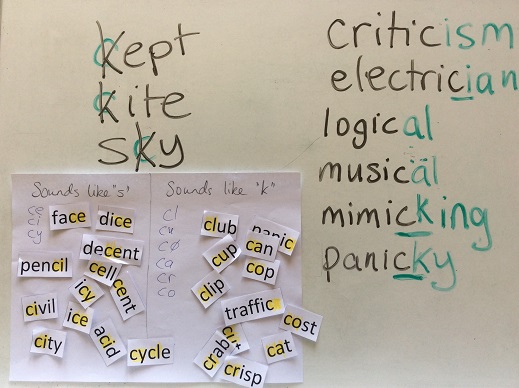C that sounds like “s”
10 Replies
The letter C can represent the sound "k" as in "cut" or the sound "s" as in "cent".
Teaching learners how this works and why it's a good thing when we start adding suffixes to words can be tricky, especially if they don't really understand "if-then" sentences yet.
Here's a 6 minute video I made about one way to do it.
Note that the spelling CC is sometimes followed by a letter E but the sound is still "k", e.g. soccer, sicced (as in "I sicced the dog onto the burglar and she ran off"). CC is like other doubled letters, its main purpose is to tell you to say a "short" vowel before it, as in raccoon, Mecca, piccolo, broccoli and buccaneer. Typically, but not always, we write CK instead of CC.
The spelling C+C might also represent a "k" sound at the end of one syllable followed by a "s" at the start of the next syllable, as in "accede", "accent", "accept", "access" and "coccyx".
Also, either a single or double C might represent a "ch" sound in some Italian-origin words e.g. cello, Botticelli, bocce (click here for more).



It helped me a lot on how to do it
This really helped me to do my homework
This really helped me when I had homework thxs ☺️
The beginning of the exercise was great, I’ll definitely be using that with my children. That last part of the video (why we don’t just use a ‘k’ or ‘s’) began by making sense ie critic to criticism the letter ‘c’ becomes a different sound. But the last couple of examples a ‘k’ could have still been used either way ie panic/panik- panicky/paniky or mimic/mimik- mimicking/mimiking, so were a little confusing.
Hi Ella, thanks for the feedback, I’m not sure I 100% understand what you mean by “k could still have been used either way” as we don’t have many words ending in “ik” in English, just a few loan words like “batik” and “sputnik” and “shaslik”. Mostly this final syllable is spelt “ic”, but when we add a suffix beginning with E or I we change c to ck, or we’d have “panicing” and “mimicing” with C as in “cent” not C as in “cat”. Hope that makes sense, maybe I should have added that clarification to the video. Hope that makes sense. Alison
this help me a lot to do daughter’s my homework
Do you have something like this to explain g and j?
Usually when letter g is before e, i or y, we pronounce it /j/, but the best way to explain this is get a whole lot of words with the SOUND /j/ and sort them into groups then eyeball the patterns, for example this online activity: https://wordwall.net/resource/18322449/words-with-j-spelt-j-g-ge-dge-dj. You could do the same thing with the words on bits of paper, sort them into groups by how the sound /j/ is spelt, then get the student to write out and eyeball the lists and talk about any patterns they notice. Starting from the SOUND is always a better way to go than starting from the LETTER(S). Hope that’s helpful. Alison
Can you please help me understand and be able to explain why when we know how to use the letter “S” or letter “C” when writing words down? E.g we know that the word celery sounds like an “s” but how do children know whether to spell it/write it down using the “C” or “S” letter? I understand the i,e or y rule in regards to reading/pronouncing words, but I’m a little stuck on finding anything that helps explain the rule when it comes to spelling it/writing it down. Thank you.
Hi, it would be great to have a simple explanation that makes sense to modern kids about why letter ‘C’ is sometimes pronounced /s/. Sadly, the reason is more complicated, and do with the location of vowel sounds in the mouth and the history of English, which is a mishmash of ancient languages, warped over time. You can find out more details here: https://historyofenglishpodcast.com/2012/07/17/episode-5-centum-satem-and-the-letter-c-2/. My kid-friendly explanation is that the languages which became English often used the letters of the alphabet differently, giving us a few ways to spell most sounds. I try to cheer them up by pointing out that the different spellings of ‘sent’, ‘cent’ and ‘scent’ help us identify both sounds and meanings, and that it’s good to have different ways to say letter ‘C’ when ‘electric’ becomes ‘electrician’, ‘music’ becomes ‘musician’ etc. We wouldn’t want to take the ‘music’ out of ‘musician’ (‘musishan’??!!). It’s actually quite clever that our spelling system allows us to preserve base word spelling in derived words.